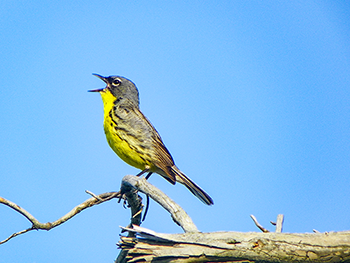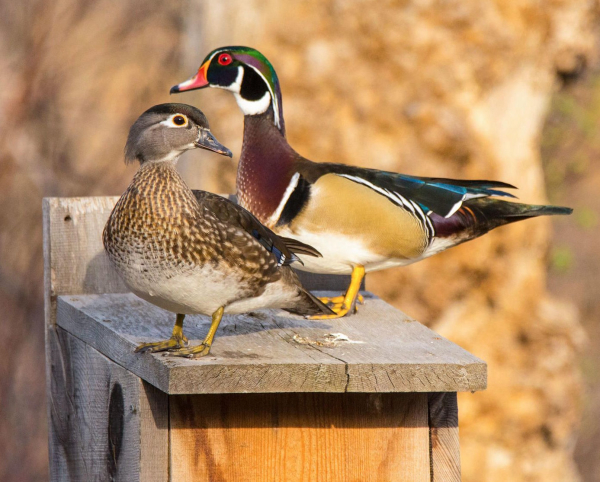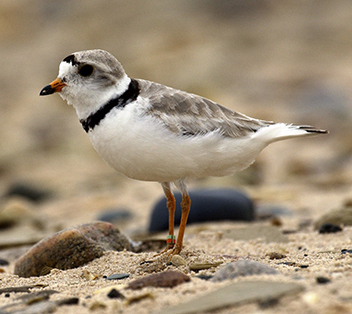Record numbers of two Michigan endangered species point to success of conservation efforts
Two Michigan endangered species are being observed in record numbers this year, due to the collaborative conservation efforts of the Department of Natural Resources and many partners.
 “We’re really excited about the survey results for the Great Lakes piping plover and Kirtland’s warbler,” said DNR Field Operations Manager Keith Kintigh. “To have both of these species reach record numbers this year shows what great partnerships can do for wildlife conservation over time.”
“We’re really excited about the survey results for the Great Lakes piping plover and Kirtland’s warbler,” said DNR Field Operations Manager Keith Kintigh. “To have both of these species reach record numbers this year shows what great partnerships can do for wildlife conservation over time.”
Piping plovers are migratory shorebirds that nest in three distinct populations in the northern United States and Canada (the Great Plains, the Atlantic Coast and the Great Lakes) and winter mainly along the Gulf Coast. In the Great Lakes, they live near shorelines and beaches and will nest in depressions of sand with rocks, shells or sticks, which can be easily disturbed by beachgoers. To protect their young, they often will distract perceived predators with a “broken-wing” act.
In 1983, there were only 13 breeding pairs of Great Lakes piping plovers in Michigan. This year, more than 158 chicks have been banded in Michigan, Wisconsin and Canada, with more than 58 nests found in Michigan alone. Of the 58 Michigan nests, 43 were in the northern Lower Peninsula and 15 in the Upper Peninsula. Sleeping Bear Dunes National Lakeshore had the highest occurrence of nests in the region.
Management partners have been crucial to the success of Great Lakes piping plover conservation. They include the University of Minnesota, National Park Service Sleeping Bear Dunes and Apostle Islands National Lakeshore, U.S. Fish and Wildlife Service, University of Michigan Biological Station, U.S. Forest Service-Hiawatha National Forest, Wisconsin Department of Natural Resources, Lake Superior State University, Detroit Zoo and many others.
 The Kirtland’s warbler is among the rarest wood warblers in North America. It nests mainly in young jack pine forests on public lands and winters in the Bahamas. In 1974 and 1987, the lowest survey numbers of Kirtland’s warblers were recorded, with only 167 singing males found.
The Kirtland’s warbler is among the rarest wood warblers in North America. It nests mainly in young jack pine forests on public lands and winters in the Bahamas. In 1974 and 1987, the lowest survey numbers of Kirtland’s warblers were recorded, with only 167 singing males found.
In 2015, biologists, researchers and volunteers observed 2,365 singing males during the official survey period. In the last full census in 2013, 2,025 males were observed. This year, 2,307 singing males were found in 13 northern Lower Peninsula counties: Antrim (2), Alcona (306), Cheboygan (3), Clare (68), Crawford (358), Iosco (295), Kalkaska (107), Montmorency (59), Ogemaw (544), Oscoda (436), Otsego (12), Presque Isle (55) and Roscommon (62). Surveyors identified 37 singing males in six Upper Peninsula counties: Alger (4), Baraga (3), Chippewa (13), Delta (5), Marquette (7) and Schoolcraft (5). Twenty-one additional singing males were observed outside Michigan in Wisconsin and Ontario.
Because of the efforts of many management partners like the U.S. Fish and Wildlife Service, U.S. Forest Service, Michigan Department of Military Affairs, Wisconsin Department of Natural Resources, The Kirtland’s Warbler Alliance, The Nature Conservancy, Huron Pines, Bahamas National Trust, Environment Canada, Canadian Department of National Defence and many others, Kirtland’s warbler numbers have steadily been increasing over the last decade.
To learn more about the Great Lakes piping plover and Kirtland’s warbler, visit Michigan.gov/wildlife.






